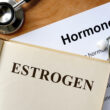In the last few years, “microbiome” has become a buzzword. We know the gut houses a universe of microbes—some of which are benevolent, others not so much. We also know that babies born via Cesarean are at a greater risk for noncommunicable diseases and have an increased risk of asthma, allergies, autoimmune disorders, and obesity[1][2]. One theory for this is that Cesarean babies don’t get the same “bacterial baptism” as their counterparts who undergo a vaginal birth. The vaginal tract contains a unique microbiome of bacteria, protozoa, viruses, and fungi. According to this theory, babies who undergo a vaginal birth get a thorough dose of these microorganisms on their way out. Could vaginal seeding reduce C-section-born children’s risk of obesity and more?
Vaginal seeding is the practice of inoculating a cotton swab with vaginal fluids to transfer microbes to a newborn infant. In theory, it’s a pretty convincing practice. Why wouldn’t it be helpful? Studies, however, find contradictory results.
Before delving into the results of these studies, we first have to address the elephant in the room. Cesarean section deliveries can be lifesaving procedures for both babies and moms. If we’re looking through the lens of a risk-benefit analysis, the benefit of mom and baby literally living through delivery far outweighs the risks associated with potential microbiome disturbance. But in an ideal situation, babies delivered via Cesarean deserve the chance to make up for microbiome discrepancies they might have compared to their counterparts born vaginally.
What we know about the gut health of babies born vaginally vs babies born via Cesarean section
The differences in gut microbiomes between babies born vaginally and through Cesarean are apparent as soon as 3 and 5 days after birth [3]. Wampach and colleagues discovered that infants born vaginally were enriched for “good bacteria” Bacteroides spp. and bifidobacterium spp. Bifidobacterium spp. are killed by antibiotics given during C-sections (more on this below).
Not surprisingly, babies born vaginally had gut microbiomes most similar to those found in the mother’s vaginal tract, while their Cesarean counterparts’ microbiomes most resembled those found on the mother’s skin and/or in the operating room [4]. A 2019 study found that these gut microbiome differences persisted through at least 4 years of age (when the study ended), while a 2014 study found that differences persisted through adulthood [5][6]. What impact these microbiome differences may have on risk of adult diseases, we don’t know. We do know that early life gut development plays a vital role in the development and maturation of the immune system and brain.
Confounding factors…is it the C-section or other variables?
As any good scientist knows, correlation doesn’t necessarily mean causation. We have to consider the confounding factors that often go along with Cesarean deliveries. Most pronounced is antibiotic use, the absence of labor (such as during a planned C-section), maternal health risk factors, and lower rates of breastfeeding. It is possible that all these things, rather than solely the mode of delivery, are playing roles in the microbiome discrepancies.
During Cesarean deliveries, all moms receive intrapartum antibiotic prophylaxis (IAP), as anyone undergoing surgery does. The antibiotics that cross the placenta would most certainly have a negative impact on the infant microbiome. Notably, IAP is associated with a delay in the production of immunomodulatory short chain fatty acids. These fatty acids are crucial for smooth digestion.
A lack of labor can create a completely different biochemical landscape for the mom and infant. In addition, the lack of rupture of fetal membranes (which occurs in an elective, planned Cesarean) inhibits exposure to maternal bacteria. Cesarean deliveries are associated with lower rates of breastfeeding, most likely due to the suboptimal breastfeeding parameters major abdominal surgery can cause—namely, pain from the incision in the abdomen renders breastfeeding difficult. Not surprisingly, moms who deliver via Cesarean often have other risk factors related to pregnancy and endocrine health, which may be connected to microbiome disturbances.
Should I consider vaginal seeding?
A 2022 literature review summarized the results of vaginal seeding studies thus far [2]. Observational studies suggest that vaginal seeding at least partially restored gut microbiome development over the first year of life. Of note, oral administration of maternal vaginal fluid did not appear to make a difference, whereas exposing C-section-born babies to their mother’s stool (yes, stool) mixed with breastmilk did lead to gut microbiomes similar to vaginally born babies [2]. Of note, and in line with what I wrote above, animal models suggest that maternal prenatal health may impact the effectiveness of vaginal seeding on gut microbiome development. To date, no serious adverse events related to vaginal seeding have been reported.
In 2017, the American College of Obstetricians and Gynecologists (ACOG) issued a position statement noting that it “does not recommend or encourage vaginal seeding outside of the context of an institutional review board-approved research protocol, and it is recommended that vaginal seeding otherwise not be performed until adequate data regarding the safety and benefit of the process become available.” ACOG’s hesitation may be due to the possibility that “unfriendly bacteria” such as Group B Strep (GBS, with which ~25% of women are colonized) may transfer to the baby via vaginal seeding. ACOG’s position paper was reaffirmed in 2022, but no research studies performed after 2017 have been added to the reference list, suggesting that the position statement is based largely upon old data.
Randomized placebo-controlled trial studies are needed to show the benefit (or not) of vaginal seeding, and two are currently underway. One is actively recruiting, with an endpoint in 2029, while the other is active and no longer recruiting, with an endpoint of 2027.
Ok, so if I have a Cesarean, what else can I do for my baby’s gut?
So if you end up with a Cesarean, what are some other things you can do to help your baby’s microbiome? Feeding breast milk, skin-to-skin contact, delayed bathing, and keeping your gut health in check should be priorities. Maternal breast milk is the single most influential factor in terms of your infant’s gut health. A newborn’s intestines are “open,” meaning very porous. Colostrum and transitional milk are designed for this very phase. If a mom does not want to or is unable to feed at the breast, I can’t overemphasize the importance of early breast milk via bottle, cup, or syringe. Any amount helps to close the intestinal wall.
Skin-to-skin contact is recommended in all births, but Cesarean moms have a special reason to prioritize it. Skin-to-skin contact helps create the biochemical environment that tells the body, “Hey, we had a baby!” This occurs primarily through the production of oxytocin. Natural labor gives a mom plenty of oxytocin; induced labor is set off by an artificial form of oxytocin (pitocin); a mom undergoing a C-section doesn’t get this hormonal cocktail. Skin-to-skin contact is the solution. It’s completely low tech, common sense, and vital to the postpartum bonding experience—even (especially!) if mom and baby were separated. Plus, it helps boost milk supply.
In the movies, babies are whisked away directly after birth, hosed down, put in a pink and blue blanket, and handed back to the mom as pristine as a new car. But recent studies have shown that delay in bathing provides skin protection and allows for absorption of vital nutrients from vernix, which leads to improved exclusive breastfeeding rates and decreased incidence of hypoglycemia and hypothermia [7]. Rethink the bath!
Lastly, taking care of your gut health will help your baby’s gut. When exclusively feeding breastmilk, you and your baby share a gut. If you are constipated, they are constipated. If you have an upset tummy, they have an upset tummy. Eating gut healthy foods and staying hydrated are all good practices, but especially during the postpartum period.
So should you consider vaginal seeding? Maybe. Maybe not. The data is just too early to tell whether this practice is effective. Thankfully, for moms who need to deliver via Cesarean, they have other courses of action to improve their baby’s gut health.
This article was updated on April 17, 2025, to reflect more current research and ongoing randomized controlled trials on the effectiveness of vaginal seeding.
References:
[1] Stinson LF, Payne MS, Keelan JA. A Critical Review of the Bacterial Baptism Hypothesis and the Impact of Cesarean Delivery on the Infant Microbiome. Front Med (Lausanne). 2018 May 4;5:135. doi: 10.3389/fmed.2018.00135. PMID: 29780807; PMCID: PMC5945806. [2] Hourigan SK, Dominguez-Bello MG, Mueller NT. Can maternal-child microbial seeding interventions improve the health of infants delivered by Cesarean section? Cell Host Microbe. 2022 May 11;30(5):607-611. doi: 10.1016/j.chom.2022.02.014. PMID: 35550663; PMCID: PMC9237654. [3]Wampach L, Heintz-Buschart A, Hogan A, Muller EEL, Narayanasamy S, Laczny CC, et al. Colonization and succession within the human gut microbiome by archaea, bacteria, and microeukaryotes during the first year of life. Front Microbiol (2017) 8:738. doi:10.3389/fmicb.2017.00738 [4] Bäckhed F, Roswall J, Peng Y, et al. Dynamics and Stabilization of the Human Gut Microbiome during the First Year of Life. Cell Host Microbe. 2015 May 13;17(5):690-703. doi: 10.1016/j.chom.2015.04.004. Erratum in: Cell Host Microbe. 2015 Jun 10;17(6):852. Jun, Wang [corrected to Wang, Jun]. Erratum in: Cell Host Microbe. 2015 Jun 10;17(6):852. doi: 10.1016/j.chom.2015.05.012. PMID: 25974306. [5] Fouhy, F., Watkins, C., Hill, C.J. et al. Perinatal factors affect the gut microbiota up to four years after birth. Nat Commun 10, 1517 (2019). https://doi.org/10.1038/s41467-019-09252-4 [6] Goedert JJ, Hua X, Yu G, Shi J. Diversity and composition of the adult fecal microbiome associated with history of cesarean birth or appendectomy: Analysis of the American Gut Project. EBioMedicine. 2014 Dec 1;1(2-3):167-172. doi: 10.1016/j.ebiom.2014.11.004. PMID: 25601913; PMCID: PMC4296728. [7] Priyadarshi M, Balachander B, Gupta S, Sankar MJ. Timing of first bath in term healthy newborns: A systematic review. J Glob Health. 2022 Aug 17;12:12004. doi: 10.7189/jogh.12.12004. PMID: 35972992; PMCID: PMC9380966Additional Reading
Is the Pill wrecking your gut?
How to Intentionally Promote Better Gut Health After Getting Off Birth Control
The Startling Ways that Birth Control May Impact Gut Health and lead to IBD
Three Science-backed, Natural Ways to Ease Childbirth and the Postpartum Period
Why It’s Important to Trust Your Intuition When It Comes to Your Health








This is an interesting topic to think about especially as we learn more about the importance of a healthy gut microbiome. I’ve always had this in the back of my mind with my c-sections. My first birth was a traumatic 52-hr labor followed by a fourth degree tear and a baby whose lungs were completely full of meconium. He developed a fever 24 hrs after birth and was on two antibiotics for one week. Thanks be to God, that he recovered fine and is now a totally healthy kid (so clearly being on antibiotics for the first week of his life which must have wiped out any bacteria he got from the birth didn’t harm him long-term). My second son was born via c-section after 24 hrs in labor and has no health conditions. My third child was born via a planned c-section. She definitely had more constipation as an infant and developed mild-moderate eczema early on. At 4 months, she then developed a candida yeast diaper rash that hung around for six months (no meds from the doctor would fix it) until I bought high-quality infant probiotics and both the diaper rash and eczema disappeared within 5 weeks (her skin is beautiful now). I wonder, was the clear problem in her gut due to the c-section or due to something else that we don’t know? Otherwise she is in great health. I breastfed all my children for 1+ yr. Just wanted to share my different experiences.